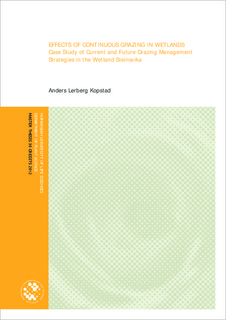| dc.contributor.author | Kopstad, Anders Lerberg | |
| dc.date.accessioned | 2013-03-26T16:32:05Z | |
| dc.date.available | 2013-03-26T16:32:05Z | |
| dc.date.copyright | 2012 | |
| dc.date.issued | 2013-03-26 | |
| dc.identifier.uri | http://hdl.handle.net/11250/189551 | |
| dc.description.abstract | Grazing herbivores are a common tool in wetland conservation management. This thesis studied the effects of continuous grazing by livestock in the freshwater meadow/fen wetland Steinsvika in Southeast Norway. By visual assessment and biological monitoring, soil surface properties, condition of grasses, signs of animal presence and other points of interest were observed and registered. Registrations were conducted through five transects in one month intervals throughout the grazing season of 2012. Results showed that under continuous grazing at low stock density, livestock overgraze patches of grass by regrazing fresh regrowth. This leads to reduced resilience of palatable plants, giving competitive advantage to unpalatable species. In populations of unpalatable species, woody species find refuge to develop, and wetlands most likely move towards a new successional level of shrub. The thesis discusses suggestions on how future grazing of wetlands can be conducted as an ecosystem approach. By subdividing the wetland into homogeneous vegetation zones and flood prone areas, and controlling density and duration of grazing, livestock may provide more predictable results, when management goals is to keep succession at a specific level. This way of managed grazing may influence bird habitats,
wanted and unwanted species, nutrient runoff as well as animal welfare and performance in a more considerate way than when managing livestock merely based on stocking density per grazing period (140 days). | no_NO |
| dc.language.iso | eng | no_NO |
| dc.publisher | Norwegian University of Life Sciences, Ås | |
| dc.subject | Grazing | no_NO |
| dc.subject | Wetland | no_NO |
| dc.subject | Agroecology | no_NO |
| dc.subject | Holistic | no_NO |
| dc.subject | Beite | no_NO |
| dc.subject | forvaltning | no_NO |
| dc.title | Effects of continuous grazing on wetlands : case study of current and future grazing management strategies in the wetland Steinsvika | no_NO |
| dc.type | Master thesis | no_NO |
| dc.subject.nsi | VDP::Agriculture and fishery disciplines: 900::Agriculture disciplines: 910::Management of natural resources: 914 | no_NO |
| dc.subject.nsi | VDP::Agriculture and fishery disciplines: 900::Agriculture disciplines: 910::Livestock breeding, rearing, reproduction: 912 | no_NO |
| dc.source.pagenumber | 38 | no_NO |
